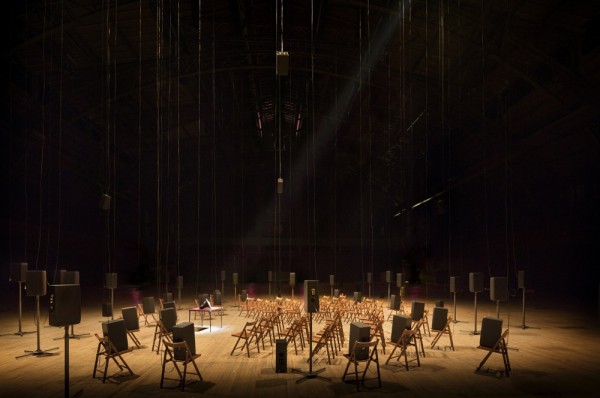 Photo credit James Ewing/Park Avenue Armory
Photo credit James Ewing/Park Avenue Armory
Janet Cardiff and George Bures Miller's sound installation "The Murder of Crows" at the Park Avenue Armory uses sound to build boundaries in space and invokes language, specifically storytelling, as a form of architecture. Unlike the original installation at the Sydney Biennale (2007), the Armory show transpires in nearly complete darkness. Ninety-eight speakers, installed in roughly concentric circles, surround a central lit area where metal folding chairs face a small table upon which rests a gramophone horn. As the listeners move away from the light, they literally feel their way with their ears, wandering blindly toward fragments of sound. Only Cardiff's recorded voice emerging from the gramophone is experienced as a unified entity. The other sounds -- mechanical sound effects: doors slamming, machines clunking, recordings of nature: waves crashing, crows cawing, wind howling, and music -- an antiphonal choral piece, Buddhist nuns chanting, and men singing an anti-fascist Soviet war song are deconstructed and dispersed throughout the enormous hall.
As with many of Cardiff/Miller installations, The Murder of Crows privileges sound over visuals. Unlike visual data over which we feel we have some control (after all, if we don't like something we can close our eyes; if we have a bad dream we open them) and which is immediately legible, sound penetrates, violates our space. Not only does it force us to receive it, it activates the cognitive processes by which reason and imagination construct the missing (unseen) thing. It is the listener's own ear that unifies the fragments, and, in this way, sound becomes spatialized with respect to the listener's body. Thus, the Murder of Crows invokes the earliest type of architecture -- those fluid delineations that designate inside/outside, self/other, known/unknown.
Humans build so that we may dwell, not become dispersed in the unknown. We tell stories so that our isolated experiences can be shared. Cardiff/Miller organize the vast space of the Armory with the simplest of props: light, folding chairs, a few benches, a table -- offering a kind of "home" for visitors amidst the chaos of sound. However, rather than congregate around a living orator, we sit facing the amputated horn of a gramophone -- that artificial larynx that heralded the modern age of communication when human speech could not only be transmitted over long distances, but no longer required a living body to broadcast it.
In this setting of looming darkness populated by instruments of technology, the recorded human voice becomes the equivalent of firelight gathering listeners to it. Cardiff's voice, emerging gravelly and raw from the gramophone horn, both exposes and attempts to counter the unknown, the dark, the not-at-home. She brings her nightmares (a factory that processes human bodies like meat, a slave/prisoner of war whose foot an army commander threatens to cut off so he cannot run away, and finally, finding a leg in a bed in her dream-home) into the light, reconstructing subconscious terrors through language and through storytelling. The piece ends with Cardiff singing -- simple, acoustic poetry and guitar. Reason would say this is a wholly inadequate antidote to the nightmares that Cardiff describes. And, yet, it is in its humbleness and humanness that her song comforts.
According to the wall text, The Murder of Crows is inspired by Goya's "The Sleep of Reason Creates Monsters" an aquatint that depicts the artist asleep at his drawing table, defenseless against the creatures of his imagination. Technology in Cardiff/Miller's work occupies a similar position to imagination in Goya. On the one hand, it can be used to create art and music (The Murder of Crows is itself proof of that) on the other it can produce those horrors of unreason --murder and war.
As with their piece the Killing Machine (2007) in which menacing machines slice and penetrate the empty space of a dentist's chair, the machines in Cardiff's dreams are the ultimate monster. Techne, which began as craft, has become a tool of our own destruction. Amputation, as invoked by the Killing Machine and, again in this piece describes a condition not only of loss, but of estrangement. The body reduced to meat becomes a torture chamber. Language, depleted of poetry, reduced to information, is no longer an art that reveals and makes the world intelligible (home,) it merely describes the structures that incarcerate us. In Cardiff's nightmares, human beings have become complicit with technology and institutions that process/use other humans as raw materials. Opposing this, The Murder of Crows employs the creative potential of technology to harness the listener's body, not for destruction, but for art.
